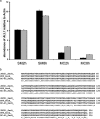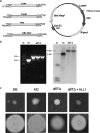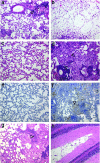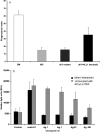Loss of allergen 1 confers a hypervirulent phenotype that resembles mucoid switch variants of Cryptococcus neoformans
- PMID: 18955480
- PMCID: PMC2612268
- DOI: 10.1128/IAI.01079-08
Loss of allergen 1 confers a hypervirulent phenotype that resembles mucoid switch variants of Cryptococcus neoformans
Abstract
Microbial survival in a host is usually dependent on the ability of a pathogen to undergo changes that promote escape from host defense mechanisms. The human-pathogenic fungus Cryptococcus neoformans undergoes phenotypic switching in vivo that promotes persistence in tissue. By microarray and real-time PCR analyses, the allergen 1 gene (ALL1) was found to be downregulated in the hypervirulent mucoid switch variant, both during logarithmic growth and during intracellular growth in macrophages. The ALL1 gene encodes a small cytoplasmic protein that is involved in capsule formation. Growth of an all1Delta gene deletion mutant was normal. Similar to cells of the mucoid switch variant, all1Delta cells produced a larger polysaccharide capsule than cells of the smooth parent and the complemented strain produced, and the enlarged capsule inhibited macrophage phagocytosis. The mutant exhibited a modest defect in capsule induction compared to all of the other variants. In animal models the phenotype of the all1Delta mutant mimicked the hypervirulent phenotype of the mucoid switch variant, which is characterized by decreased host survival and elevated intracranial pressure. Decreased survival is likely the result of both an ineffective cell-mediated immune response and impaired phagocytosis by macrophages. Consequently, we concluded that, unlike loss of most virulence-associated genes, where loss of gene function results in attenuated virulence, loss of the ALL1 gene enhances virulence by altering the host-pathogen interaction and thereby impairing clearance. Our data identified the first cryptococcal gene associated with elevated intracranial pressure and support the hypothesis that an environmental opportunistic pathogen has modified its virulence in vivo by epigenetic downregulation of gene function.
Figures






Similar articles
-
ALL2, a Homologue of ALL1, Has a Distinct Role in Regulating pH Homeostasis in the Pathogen Cryptococcus neoformans.Infect Immun. 2015 Nov 23;84(2):439-51. doi: 10.1128/IAI.01046-15. Print 2016 Feb. Infect Immun. 2015. PMID: 26597983 Free PMC article.
-
Identification of App1 as a regulator of phagocytosis and virulence of Cryptococcus neoformans.J Clin Invest. 2003 Oct;112(7):1080-94. doi: 10.1172/JCI18309. J Clin Invest. 2003. PMID: 14523045 Free PMC article.
-
Phenotypic switching and its implications for the pathogenesis of Cryptococcus neoformans.FEMS Yeast Res. 2006 Jun;6(4):480-8. doi: 10.1111/j.1567-1364.2006.00039.x. FEMS Yeast Res. 2006. PMID: 16696644 Free PMC article. Review.
-
Phenotypic switching in Cryptococcus neoformans.Microbiology (Reading). 2006 Jan;152(Pt 1):3-9. doi: 10.1099/mic.0.28451-0. Microbiology (Reading). 2006. PMID: 16385110 Free PMC article. Review.
-
Identification of Pathogen Genomic Differences That Impact Human Immune Response and Disease during Cryptococcus neoformans Infection.mBio. 2019 Jul 16;10(4):e01440-19. doi: 10.1128/mBio.01440-19. mBio. 2019. PMID: 31311883 Free PMC article.
Cited by
-
Aging: an emergent phenotypic trait that contributes to the virulence of Cryptococcus neoformans.Future Microbiol. 2015;10(2):191-7. doi: 10.2217/fmb.14.124. Future Microbiol. 2015. PMID: 25689531 Free PMC article.
-
Aging as an emergent factor that contributes to phenotypic variation in Cryptococcus neoformans.Fungal Genet Biol. 2015 May;78:59-64. doi: 10.1016/j.fgb.2014.10.004. Epub 2014 Oct 13. Fungal Genet Biol. 2015. PMID: 25307541 Free PMC article. Review.
-
A novel specificity protein 1 (SP1)-like gene regulating protein kinase C-1 (Pkc1)-dependent cell wall integrity and virulence factors in Cryptococcus neoformans.J Biol Chem. 2011 Jun 10;286(23):20977-90. doi: 10.1074/jbc.M111.230268. Epub 2011 Apr 12. J Biol Chem. 2011. PMID: 21487010 Free PMC article.
-
Characterization of the virulence of Cryptococcus neoformans strains in an insect model.Virulence. 2015;6(8):809-13. doi: 10.1080/21505594.2015.1086868. Epub 2015 Sep 12. Virulence. 2015. PMID: 26364757 Free PMC article. No abstract available.
-
ALL2, a Homologue of ALL1, Has a Distinct Role in Regulating pH Homeostasis in the Pathogen Cryptococcus neoformans.Infect Immun. 2015 Nov 23;84(2):439-51. doi: 10.1128/IAI.01046-15. Print 2016 Feb. Infect Immun. 2015. PMID: 26597983 Free PMC article.
References
-
- Casadevall, A., and L. A. Pirofski. 2003. “Anti-virulence” genes—further muddling the lexicon? Response from Arturo Casadevall and Liise-anne Pirofski. Trends Microbiol. 11413-414. - PubMed
Publication types
MeSH terms
Substances
Grants and funding
LinkOut - more resources
Full Text Sources

